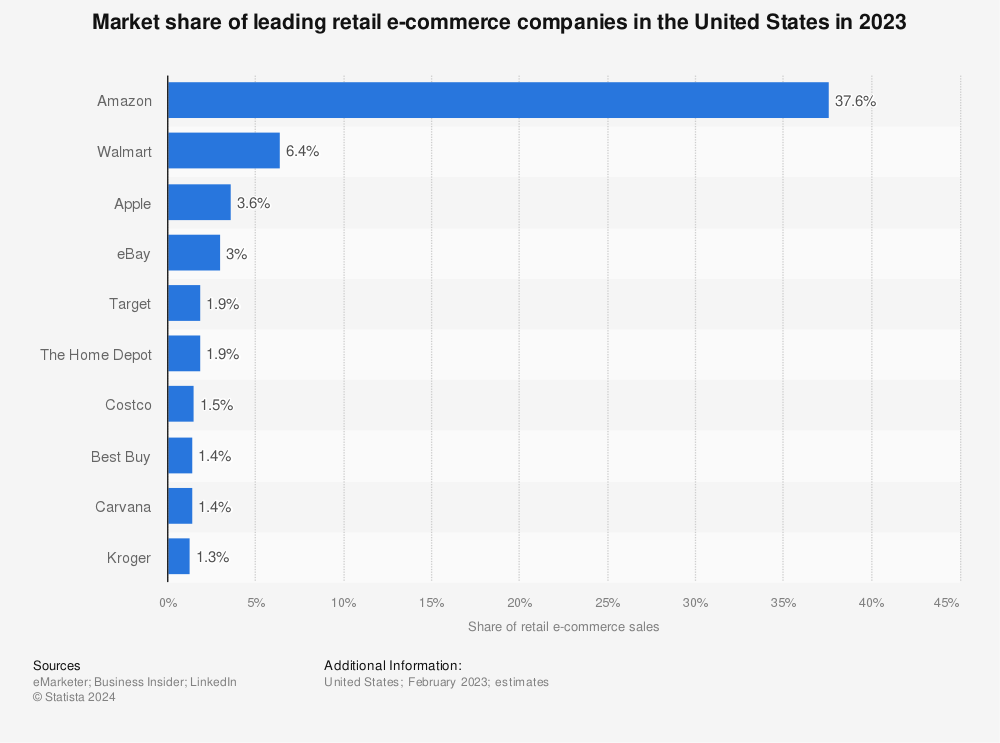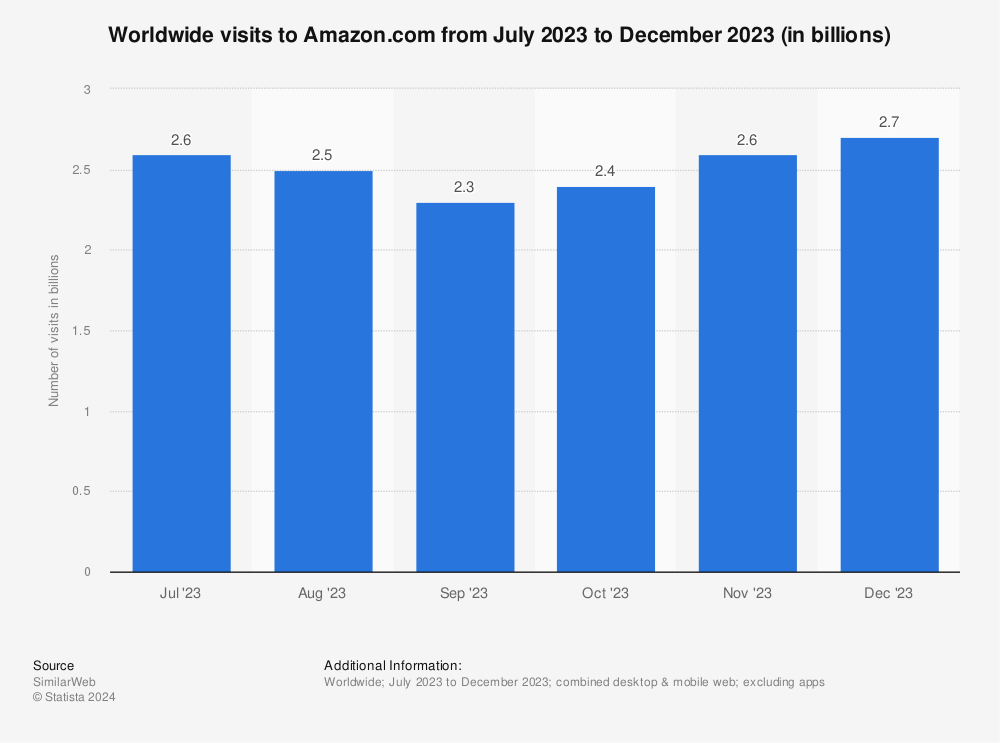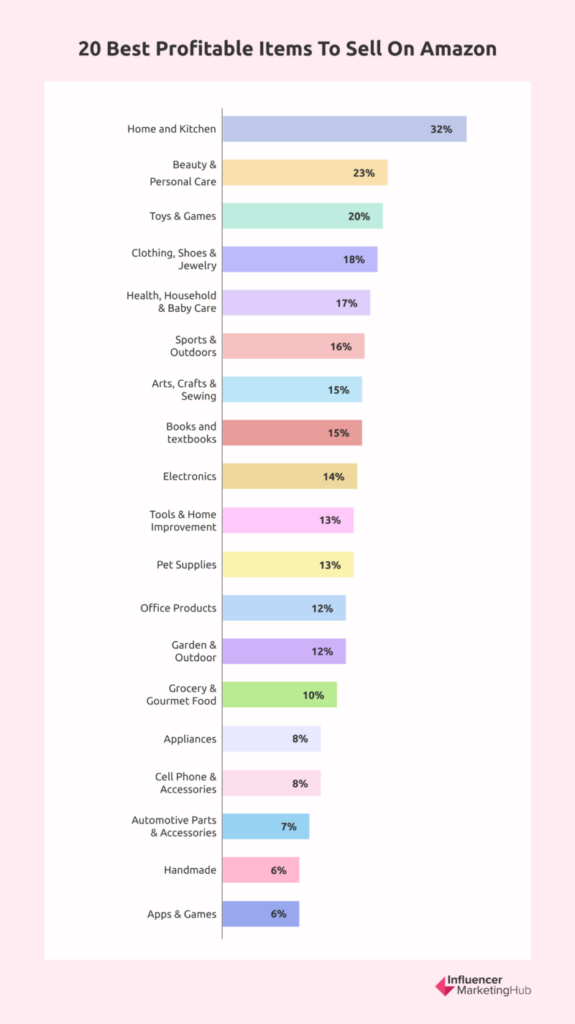Within the span of a few decades, online shopping has become an integral part of consumer purchase behaviors, with more and more people becoming more comfortable with buying goods and booking services via digital channels.
In fact, it’s estimated that over 2 billion individuals worldwide are expected to do their shopping online. Consumers prefer online shopping because of the convenience and accessibility it offers. Some also prefer it because of the competitive prices ecommerce merchants offer. It comes as no surprise that Amazon is one of the leading ecommerce platforms in the US, taking 37.8% of the US ecommerce market share as of June 2022.
Amazon Bestsellers List by Category
In the US alone, it’s the most visited ecommerce website, with approximately 2.45 billion visits monthly.
The platform has more than 6 million sellers worldwide, with nearly 2 million of them counting as active sellers. It’s an immense marketplace that sells over 12 million products. If you include books, media, and services in the Amazon Marketplace, the ecommerce platform has more than 350 million products up for sale.
During the third quarter of 2022, Amazon’s net sales increased by 9.66%, bringing its net revenue to $121.7 billion. In the fourth quarter, it’s estimated that sales will grow between $130 billion and $140 billion. What’s remarkable about all these figures is that third-party sellers sold 57% of paid units, generating more than $27 billion in revenue. Moreover, almost half of all sellers on the platform were able to generate significant revenue from sales, amounting to 81% to 100%.
The bottom line is, selling on Amazon can be profitable, especially if you’re looking to have a new revenue stream. However, while joining the Amazon Seller Central is relatively easy, finding products to sell on the platform can be especially tricky. Given the sheer volume of items being sold on the site and the number of Amazon sellers, it can be tough to find the right product niche that can turn a profit.
What are the best products to sell on Amazon? How would you know if a product is profitable? What do you need to consider before you even start selling on the platform? This guide can help you answer these questions.
Your Guide to Knowing What to Sell on Amazon in 2024:
What You Need to Know Before Selling on Amazon
Amazon has made it easier for new sellers to enter its marketplace. However, despite the ease of signing up, success isn’t always guaranteed. What does it take to succeed as an Amazon seller? Will your business type work on Amazon? Before jumping on the bandwagon, there are some things you need to consider:
?There’s bound to be a lot of competition
With millions of active sellers, you’ll be facing tough competition, especially if you’re working with a broad or popular category. You first need to determine what your niche is and work on building your brand and online presence. You want your business to stand out and have a competitive edge. It’s important that you consider niching down and optimizing your listing and offerings so that you’d be able to perform well within that niche.
?Listings don’t always translate to sales
While you’re free to create a listing for your products, doing this doesn’t always guarantee that your products will sell. To become a successful seller, you need to utilize Amazon’s seller tools, as well as third-party tools that can help you gather data, insights, run ads, and optimize your listings.
?You need to determine what your business model will be
Which route are you going to take? Will you be a reseller or do you want to market private label products? Perhaps you want to try dropshipping? Each of these business models work differently on Amazon.
?There are seller fees
Yes, Amazon has seller fees, especially if you’ve signed up for Amazon FBA. Fees include referral fees, fulfillment fees, inventory fees, and refund administration fees.
How to Find Profitable Products to Sell on Amazon
While you can sell almost anything on Amazon, not every product can be profitable. Try to find out which products are selling, why people are buying them, and how consumers are finding these items online, according to Chris Dunne.
When joining the Amazon marketplace as a third-party seller, you need to market products that are profitable and have a steady demand, without drowning in categories that are already oversaturated.
Here are some tips on how you can start finding products that can turn a profit:
Do Your Research
Research can spell the difference between success and failure. Yes, “research” is a broad term, so let’s narrow it down by category.
Check the Amazon Best Sellers List
Amazon’s Best Seller list is a good place to start. It features the most popular products based on sales and the list is updated hourly. It covers all departments, from Amazon Device and Accessories to Video Games and gives you a good idea of what customers are buying the most under each category.
Conduct Keyword Research
Keyword research can help you determine which products consumers are looking for. You can use third-party tools such as Ahrefs or Jungle Scout. Alternatively, you can use the Amazon search bar for product keyword searches.
Look Out for Market Trends
Market trends give you a glimpse of product demand over a period of time. If you’re selling a niche or seasonal product, for example, you can use data from market trend reports to determine the best time to sell your product. You can also use this data to find out whether or not your product is in demand or can be sold throughout the year.
Find Your Niche
Niche refers to a specialized segment or subcategory that offers a specific type of product or service. When it comes to Amazon, “niching down” or being able to identify a more specific niche with less competition and performing well within that category can help you generate good profit.
By having a niche, you’d have less competition and less barriers to entry. It’s worth noting that niching down may not work for everyone. Some sellers who are working in broad categories still manage to be successful.
Avoid Competing With Big Brands
Going head-to-head against big brands isn’t exactly a good idea. This is because big brands already have several advantages, including having an established reputation among consumers, sizeable budgets, and powerful marketing campaigns.
This is where niching down comes into play. It’s almost impossible to compete with Adidas or New Balance if you’re thinking of selling shoes. If you have a niche like “orthopedic shoes for women”, for example, then you’re likely to have less competition.
Leverage Product Reviews
Product reviews can be a good resource for further insights into a particular product. If you see a lot of reviews, this can indicate that this market segment is saturated. Too few and it can point to a lack of demand for the product. However, the dearth of reviews doesn’t automatically mean that a product isn’t good or in demand. It’s possible that the product itself is excellent, but it has yet to garner a significant number of reviews.
Think Carefully About Your Product’s Dimensions
Before deciding on a product to sell on Amazon, it’s important that you consider its dimensions and weight, as these can affect your storage, shipment, and their corresponding fees. If possible, try looking for products that are easy to ship and store if you’re trying to cut down on storage and shipping costs.
Another helpful tip is finding other products within your niche that have the potential to sell well, especially if you’re thinking of scaling up your business. If your first product is a success, what other products in the same niche can you sell next?
3 Characteristics of a Good Product to Sell
According to Ankitha Nagaraj, to succeed on Amazon, you need three key factors:
- The right product for your business or niche
- The appropriate strategies to market this product
- The right motivation that will help you maintain your business or performance
Aside from these success factors, you also need to determine the characteristics of a product that you’re going to sell on Amazon. Knowing the characteristics of a good product to sell can help you narrow down your selection. Ideally, these products should be:
Affordable
Consider selling products that are affordable but can still be sold at a profit. Products that do well in sales typically have prices that range between $20 and $50. Keep in mind that you also have to factor in other costs such as Amazon seller fees and the cost of the product itself.
Easy to source
Find a product that’s easy to source. Ideally, your product should be easy to manufacture or something that can be supplied quickly without compromising its quality.
Evergreen
While seasonal products can still potentially generate revenue, they’re not evergreen. When researching for products, you want to find something that you can sell throughout the year and not just on special occasions.
20 Best Profitable Items to Sell on Amazon
Amazon covers a lot of product categories. However, some categories are more popular than others. In 2022, Home and Kitchen was ranked as the most popular category, with 32% of sellers having products listed under it. This is followed by:
- Beauty & Personal Care – 23%
- Toys & Games- 20%
- Clothing, Shoes & Jewelry – 18%
- Health, Household & Baby Care – 17%
Additionally, here are some popular and easy to sell items. Do note that given their popularity, you may have a lot of competition:
- Sports & Outdoors – 16%
- Arts, Crafts & Sewing – 15%
- Books and textbooks – 15%
- Kitchen & Dining – 14%
- Electronics – 14%
- Tools & Home Improvement – 13%
- Pet Supplies – 13%
- Office Products – 12%
- Garden & Outdoor – 12%
- Grocery & Gourmet Food – 10%
- Appliances – 8%
- Cell Phone & Accessories – 8%
- Automotive Parts & Accessories – 7%
- Handmade – 6%
- Apps & Games – 6%
If you’re looking to enter the Amazon marketplace, here are some categories that are worth considering:
✅Arts and crafts materials
✅Beauty and personal care products
✅Cameras and photography equipment
✅Cookware or bakeware
✅EBooks
✅Gourmet food
✅Handmade products
✅Home entertainment
✅Home office furniture
✅Kitchen storage products
✅Laptops
✅Luggage
✅Office products
✅Pet supplies
✅Swimwear
✅Sports apparel
✅Sports equipment
✅Tools
✅Video games
✅Yoga mats
Note that these categories reflect the shopping trends in 2020 and 2021. These are broad categories and some big brands are already dominating in some of them. However, items in these markets can still be profitable, especially if you do your research and find your niche.
While we’re on the subject, here’s a list of some products that you should refrain from selling on Amazon. Selling these products can lead to suspension or termination of your selling privileges, among other sanctions. For a full list of restricted products, click here:
❌Alcohol
❌Animals or animal-related items, such as fur or feathers and pets
❌Food and beverage
❌Lock picking and theft devices
❌Recalled products
❌Surveillance equipment
Final Thoughts
Amazon has made its marketplace more accessible to sellers. However, success as a seller requires a lot of work, especially when it comes to researching. Identify which products are profitable and can be sold virtually. Also consider factors such as the number of competitors you have, the demand for your product, and your niche. You also have to optimize your listing and apply best practices such as providing accurate product data and regularly checking for orders and your inventory.
Frequently Asked Questions
What are the top-selling items on Amazon?
Some of the best-selling items on Amazon include:
- Personal care items
- Games and puzzles
- Fitness equipment
- Pet supplies
- Books
- Electronics
- Clothing
- Home and kitchen supplies or equipment
- Outdoor and camping products
- Gardening products
Is it possible to make a living from selling on Amazon?
Yes, it’s possible to make money on Amazon. Sellers can make anywhere from $1,000 to $250,000 per month. Profit margins for sellers can range from 1% to 5% and up to 51% to 100%.
What do I need to know before becoming an Amazon seller?
Here are some things to remember before becoming an Amazon seller:
- Determine what kind of seller you want to be. Do you want to be a reseller or a dropshipper, or do you want to market handmade products?
- Do your research when it comes to your potential profits. Yes, a product may rank number 1 on Amazon, but if plenty of other sellers are offering the same product, then you’d be up against a lot of competition.
- Figure out where you’re going to source your products and your logistics.
- Familiarize yourself with Amazon’s guidelines and policies. For example, violation of listing restrictions can result in cancellation of listings or suspension or removal of your listing privileges.
- Have a solid business plan, which includes identifying your inventory and knowing how you’ll source it.
What are the differences between selling on Amazon and selling on eBay?
When it comes to returning products, Amazon makes it easy for shoppers to return items for a full refund with their A-Z Guarantee. Meanwhile, eBay’s return process can be a bit complicated, as sellers can check the “No Returns” box, preventing buyers from returning the products.
Another difference between the two is the range of fulfillment methods available. Amazon gives sellers two options: you can fulfill the orders yourself through their Fulfillment by Merchant or FBM program or you can let Amazon take care of your orders for you through their Fulfillment by Amazon or FBA program.
They also differ when it comes to seller fees and the type of products you can sell.
Additionally, eBay also follows an auction model, making it ideal for sellers looking to market used items. Amazon is a retailer that also has a marketplace for its third-party sellers.
What is Amazon FBA?
Fulfillment by Amazon or Amazon FBA is a program designed to aid sellers in handling order fulfillment, from storage to shipping. It also covers customer service and returns.







